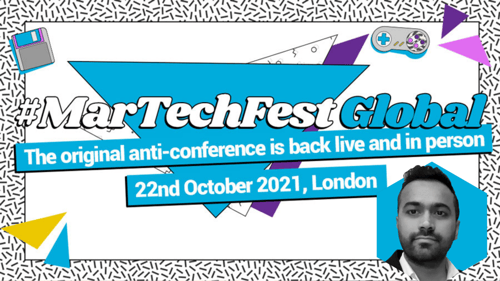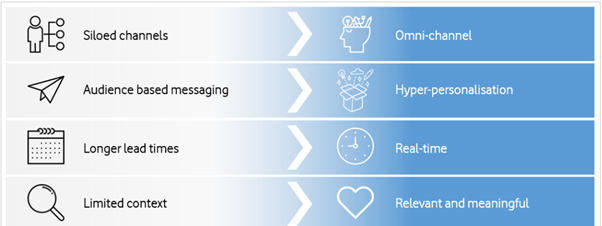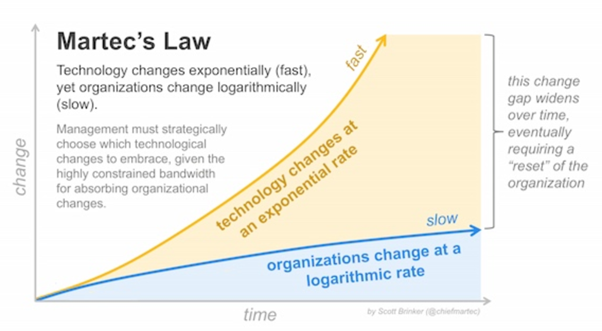For those lucky enough to catch him at #MarTechFest Global, Jobin Joy gave us a rundown of Vodafone's 'Always on' marketing.

And for those of you who missed it...well, you're out of the exclusive club. You'll never know what Jobin said. You'll never have seen the 15 backflips in a row he did. Or get a slice of triple quadruple chocolate cake that was handed out. Or see that tiger he tamed. He really was a (Jobin) Joy.
Okay, fine, we can still give you an insight into what was said by Vodafone's Group Martech lead. Just no theatrics. 🎪🐘🎈🎩
Jobin notes the evolution of marketing. He, personally, started his professional life in the call centre of a bank, ringing people at 9:30pm. Predictably, he got a lot of customers saying they'd 'sleep on it.'
Now, recently, he overheard a salesman on the high street, trying to sell a service to a lady. Nothing salacious, you. Jobin could see she was convinced. Again, nothing salacious. But what the guy was hearing from the customer was "can I get this deal online?"
…and that's the evolution of marketing.
There's been an explosion of the digital, which has given consumers so many choices. They now have the flexibility to choose the channel of their, well, choice. They can research at home, or receive great CX in person.
There's been a move...
From: To:

and this is the principle of 'always on' marketing. Though, how is this built?
This principle is built on three blocks:
- Data and Insights
- Decisioning and Orchestration
- Creative and Activation.
So, let's start with:
Data and insights
“Picking the right tool doesn’t necessarily mean every organisation goes to the same vendor for that tool. It’s what’s right for you as a business”
- Jobin Joy, Vodafone.
Vodafone have managed to centralise their data processing, identity creation, advanced ML and AI, all in one place - the data lake.
Though this might sound like a Y2K horror film about teens being picked off by a computer, it's pretty damn technical.
So, this means that you'll need huge support from a tech team to build and maintain all of it. As a marketer, it's likely you won't know the technicalities behind it, so you'll need something you understand and use.
Vodafone offers a SaaS-based platform, like a CDP and web analytics, where a marketer or analyst can look at the insights coming from the data lake or customer touchpoints, and the CDP can step up and take the role of merging the offline and online profile to create a single marketing profile. All in real time.
Plus, the CDP allows you to push all of this to any platform of your choice.
Touching on the importance of security and privacy, Jobin stresses meticulousness.
Making sure data and insights is built in a way to avoid it becoming compromised is vital. This can involve encryption, or hashing. This means, then, you can activate this data in the channels of your choice.
Overall, data and insights are nothing but what the consumer gives you, in terms of intent, and then the insights gained. Then, it's about attaching that to the profile of the customer, and handing all this over to decisioning. But what even is:
Decisioning and orchestration
Decisioning is where the omnichannel approach kicks in. It's all about using logic to build a segment, the 1-2-1.
So, it starts with having a profile, building the models in the intent layer, then bringing it to the decisioning layer. All in order to make the right decisions for the consumer. Jobin reminds us that:
What is relevant to you, is not relevant to me. So it's two different messages, two different offers, and then pushing that back into the channel."
This conundrum has led to Vodafone using a single brain across their markets. This is a single decisioning engine enabling 1-2-1 communication, so that the consumer will receive a consistent, harmonious experience.
Paid marketing, on the other hand, is a bit more difficult. You can't exactly micro-target on Facebook, after all. So, Vodafone takes this data and adds it to a CDP to create an audience, and then pushes it out to the paid channel. This gives the flexibility to optimise paid media, to lead to a better CPM.
Right, next up is:
Creative and Activation
What does activation means as a marketer? "Do I have the ability to pick and choose my channel, and push that message out to the consumer?" asks Jobin.
Well, he says, you need something that offers seamless integration. So, this is where the activation comes in.
Once the insight is gained, the decisions have been made, the message has been realised, and you've pushed it out to the chosen channel, there's one last puzzle piece. And that's content.
This means centralisation, and an asset management platform brings all your content together.
So, you can take the type of phone a person has looked at, or an article they've read on a news site, and take the context. Then, you can use your dynamic optimisation tool to pick and choose the right asset, to overlay over the ad.
Ways of working
The 'ways of working' with the martech space is the fundamental thing to fix, says Jobin.
Scott Brinker's Martec's Law graph is relevant here:

So, how do you build a team that has the right skillset?
What Vodafone did to address this two years ago involved a huge shift. They removed the traditional ways of working, and moved towards a more agile structure. Martech, then, becomes something that provides support across the company, no matter what the target.
Rather than focusing on the product or segment, the team has a single view and aim, plus the support to achieve this.
Tech tends to outgrow organisation change. How do we cope with the rapidly evolving marketing technology landscape? Well, companies must keep assessing, and reassessing, their martech.
What Vodafone has done to tackle this issue is to introduce their 'martech lab'. And no, that's not a Labrador counterpart to our martech pug, Paco.
Instead it involves businesses that are busy working against their targets, so don't have time to try the martech that's out there. Change takes time. So, the role of the martech lab is to bring together a team with a bunch of skillsets, that have created a sandbox so they can test everything end-to-end.
What are the results?
Vodafone expects to see substantial increase in incremental revenue.
They are seeing encouraging signs from their early adopter markets that reinforce the hypothesis that hyper-personalisation, based on an incredibly rich picture of the customer and in-the-moment decisioning, is a gamechanger.
With Vodafone Spain, they've seen a 5X improvement in redemption rates and a 3X improvement in value generated. Not all this lift can be attributed to capturing and using intent, but the use of context is baked into a wider transformation.
The results they've received have pushed the idea that in-the-moment decisioning, based on a 360-degree view of the customer is vital, and current.
Jobin summarises that:
- Customers are demanding, they have complex choices and access to extensive list of touchpoints. Find flexible ways to deploy the best technology stack that suits your organisation to ensure you meet their demand.
- Have a mechanism to continuously assess and improve your martech tools and integration
- Understand the importance of delivering personalised 1-2-1 communication. and optimise delivery across owned and paid channels
- Establish ways of working to bring agility and time to market. Strict process and governance to reduce overlaps.
Our six week Essentials of Martech: The 4Ps of Marketing Technology training course begins in February 2022. Enrol now!
